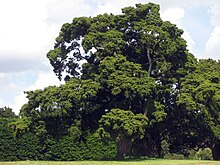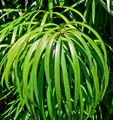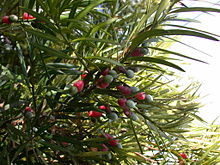| Podocarpus Temporal range: Paleocene to recent 66–0 Ma PreꞒ Ꞓ O S D C P T J K Pg N | |
|---|---|

| |
| Podocarpus totara | |
| Scientific classification | |
| Kingdom: | Plantae |
| Clade: | Tracheophytes |
| Clade: | Gymnospermae |
| Division: | Pinophyta |
| Class: | Pinopsida |
| Order: | Araucariales |
| Family: | Podocarpaceae |
| Genus: | Podocarpus L'Hér ex Pers. |
| Type species | |
| Podocarpus elongatus L'Hér ex Pers. | |
| Species | |
|
About 97–107 species, see list | |
| Synonyms | |
| |
Podocarpus (/ˌpoʊdəˈkɑːrpəs/) is a genus of conifers, the most numerous and widely distributed of the podocarp family, the Podocarpaceae. Podocarpus species are evergreen shrubs or trees, usually from 1 to 25 m (3 to 82 ft) tall, known to reach 40 m (130 ft) at times. The cones have two to five fused cone scales, which form a fleshy, berry-like, brightly coloured receptacle at maturity. The fleshy cones attract birds, which then eat the cones and disperse the seeds in their droppings. About 97 to 107 species are placed in the genus depending on the circumscription of the species.
Species are cultivated as ornamental plants for parks and large gardens. The cultivar 'County Park Fire' has won the Royal Horticultural Society's Award of Garden Merit.
Etymology
The name comes from Greek πούς poús meaning "foot" and καρπός karpós meaning "fruit".
Names
Common names for various species include "yellowwood" and "pine", as in the plum pine (Podocarpus elatus) or the Buddhist pine (Podocarpus macrophyllus).
Description
Podocarpus species are evergreen woody plants. They are generally trees, but may also be shrubs. The trees can reach a height of 40 metres (130 ft) at their tallest. Some shrubby species have a decumbent growth habit. The primary branches form pseudowhorls around the trunk. The bark can be scaly or fibrous and peeling with vertical strips. Terminal buds are distinctive with bud scales that are often imbricate and can be spreading.
The leaves are simple and flattened, and may be sessile or short petiolate. The phyllotaxis or leaf arrangement is spiral, and may be subopposite on some shoots. The leaves are usually linear-lanceolate or linear-elliptic in shape, though they can be broader lanceolate, ovate, or nearly elliptic in some species. Juvenile leaves are often larger than adult leaves, though similar in shape. The leaves are coriaceous and have a distinct midrib. The stomata are usually restricted to the abaxial or underside of the leaf, forming two stomatal bands around the midrib.
Podocarpus spp. are generally dioecious, with the male pollen cones and female seed cones borne on separate individual plants, but some species may be monoecious. The cones develop from axillary buds, and may be solitary or form clusters.
The pollen cones are long and catkin-like in shape. They may be sessile or short pedunculate. A pollen cone consists of a slender rachis with numerous spirally arranged microsporophylls around it. Each triangular microsporophyll has two basal pollen-producing pollen sacs. The pollen is bisaccate.
The seed cones are highly modified with the few cone scales swelling and fusing at maturity. The cones are pedunculate and often solitary. The seed cone consists of two to five cone scales of which only the uppermost one or rarely two nearest the apex of the cone are fertile. Each fertile scale usually has one apical ovule. The infertile basal scales fuse and swell to form a succulent, usually brightly colored receptacle. Each cone generally has only one seed, but may have two or rarely more. The seed is attached to the apex of the receptacle. The seed is entirely covered by a fleshy modified scale known as an epimatium. The epimatium is usually green, but may be bluish or reddish in some species.
-
 Leaves of P. henkelii
Leaves of P. henkelii
-
 Male cones of P. macrophyllus grow in clusters.
Male cones of P. macrophyllus grow in clusters.
-
 A seed cone of P. totara showing a red receptacle and a green epimatium
A seed cone of P. totara showing a red receptacle and a green epimatium
-
A seedling of P. elatus
Distribution
The natural distribution of the genus consists of much of Africa, Asia, Australia, Central and South America, and several South Pacific islands. The genus occurs from southern Chile north to Mexico in the Americas and from New Zealand north to Japan in the Asia-Pacific region.
Podocarpus and the Podocarpaceae were endemic to the ancient supercontinent of Gondwana, which broke up into Africa, South America, India, Australia-New Guinea, New Zealand, and New Caledonia between 105 and 45 million years ago. Podocarpus is a characteristic tree of the Antarctic flora, which originated in the cool, moist climate of southern Gondwana, and elements of the flora survive in the humid temperate regions of the former supercontinent. As the continents drifted north and became drier and hotter, podocarps and other members of the Antarctic flora generally retreated to humid regions, especially in Australia, where sclerophyll genera such as Acacia and Eucalyptus became predominant. The flora of Malesia, which includes the Malay peninsula, Indonesia, the Philippines, and New Guinea, is generally derived from Asia, but includes many elements of the old Gondwana flora, including several other genera in the Podocarpaceae (Dacrycarpus, Dacrydium, Falcatifolium, Nageia, Phyllocladus, and the Malesian endemic Sundacarpus), and also Agathis in the Araucariaceae.
Classification

| This section needs additional citations for verification. Please help improve this article by adding citations to reliable sources in this section. Unsourced material may be challenged and removed. (October 2023) (Learn how and when to remove this message) |
The two subgenera, Podocarpus and Foliolatus, are distinguished by cone and seed morphology.
In Podocarpus, the cone is not subtended by lanceolate bracts, and the seed usually has an apical ridge. Species are distributed in the temperate forests of Tasmania, New Zealand, and southern Chile, with a few occurring in the tropical highlands of Africa and the Americas.
In Foliolatus, the cone is subtended by two lanceolate bracts ("foliola"), and the seed usually lacks an apical ridge. The species are tropical and subtropical, concentrated in eastern and southeastern Asia and Malesia, overlapping with subgenus Podocarpus in northeastern Australia and New Caledonia.
Species in family Podocarpaceae have been reshuffled a number of times based on genetic and physiological evidence, with many species formerly assigned to Podocarpus now assigned to other genera. A sequence of classification schemes has moved species between Nageia and Podocarpus, and in 1969, de Laubenfels divided the huge genus Podocarpus into Dacrycarpus, Decussocarpus (an invalid name he later revised to the valid Nageia), Prumnopitys, and Podocarpus.
Some species of genus Afrocarpus were formerly in Podocarpus, such as Afrocarpus gracilior.
| Phylogeny of Podocarpus | ||||||||||||||||||||||||||||||||||||||||||||||||||||||||||||||||||||||||||||||||||||||||||||||||||||||||||||||||||||||||||||||||||||||||||||||||||||||||||||||||||||||||||||||||||||||||||||||||||||||||||||||||||||||||||||||||||||||||||||||||||||||||||||||||||||||||||||||||||||||||||||||||||||||||||||||||||||||||||||||||||||||||||||||||||||||||||||||||||||||||||||||||||||||||||||||||||||||||||||||||||||||||||||||||||||||||||||||||||||||||||||||||||||||||||||||||||||||||||||||||||||||||||||||||||||||||||||||||||||||||||||||||||||||||||||
|
Species
- Subgenus Podocarpus
- section Podocarpus (eastern and southern Africa)
- section Scytopodium (Madagascar, eastern Africa)
- section Australis (southeast Australia, New Zealand, New Caledonia, southern Chile)

P. totara - section Crassiformis (northeast Queensland)
- section Capitulatis (central Chile, southern Brazil, the Andes from northern Argentina to Ecuador)
- section Pratensis (southeast Mexico to Guyana and Peru)
P. oleifolius - section Lanceolatis (southern Mexico, Puerto Rico, Lesser Antilles, Venezuela to highland Bolivia)
- section Pumilis (southern Caribbean islands and Guiana Highlands)
- section Nemoralis (central and northern South America, south to Bolivia)
- Subgenus Foliolatus
- section Acuminatus (Sikkim, India to Borneo, New Guinea, New Britain, and northern Queensland)
- Podocarpus dispermus C.T.White
- Podocarpus hookeri de Laub.
- Podocarpus ledermannii Pilg. (section type)
- Podocarpus marginalis de Laub.
- Podocarpus micropedunculatus de Laub.
- section Bracteatus (Sumatra to Fiji)
- Podocarpus atjehensis (Wasscher) de Laub.
- Podocarpus bracteatus Blume
- Podocarpus confertus de Laub.
- Podocarpus degeneri (N.E.Gray) de Laub.
- Podocarpus pseudobracteatus de Laub.
- section Foliolatus (Nepal to Sumatra, the Philippines, and New Guinea to Tonga)

P. neriifolius - Podocarpus colliculatus (N.E.Gray) de Laub. (treated as a synonym of P. sylvestris J.Buchholz by Plants of the World Online)
- Podocarpus idenburgensis N.E.Gray
- Podocarpus insularis de Laub.
- Podocarpus neolinearis Idrees & Z.Yong Zhang (syn. Podocarpus linearis de Laub.)
- Podocarpus neglectus de Laub.
- Podocarpus neriifolius D.Don (section type)
- Podocarpus pallidus N.E.Gray
- Podocarpus rubens de Laub.
- Podocarpus vanuatuensis de Laub.
- section Globulus (Taiwan to Vietnam, Sumatra and Borneo, and New Caledonia)
- Podocarpus annamiensis N.E.Gray
- Podocarpus beecherae de Laub. (section type)
- Podocarpus globulus de Laub.
- Podocarpus lucienii de Laub.
- Podocarpus nakaii Hayata
- Podocarpus oblongus de Laub.
- Podocarpus sylvestris J.Buchholz
- Podocarpus teysmannii Miq. (syn. Podocarpus epiphyticus de Laub. & Silba)
- section Longifoliolatus (Peninsular Malaysia and Sumatra east to Fiji)
- Podocarpus decipiens N.E.Gray
- Podocarpus decumbens N.E.Gray
- Podocarpus deflexus Ridl.
- Podocarpus levis de Laub.
- Podocarpus longefoliolatus Pilg. (section type)
- Podocarpus novoguineensis de Laub.
- Podocarpus polyspermus de Laub.
- Podocarpus salomoniensis Wasscher
- section Gracilis (southern China, across Malesia to Fiji)
- Podocarpus affinis Seem.
- Podocarpus glaucus Foxw.
- Podocarpus pilgeri Foxw.
- Podocarpus ramosii R.R.Mill
- section Macrostachyus (Eastern India to New Guinea)
- Podocarpus archboldii N.E.Gray (syn. Podocarpus crassigemmis de Laub.) (section type)
- Podocarpus brassii Pilg.
- Podocarpus brevifolius (Stapf) Foxw.
- Podocarpus indonesiensis de Laub. & Silba (synonym of Podocarpus rubens de Laub. per Plants of the World Online)
- Podocarpus lenticularis de Laub.
- Podocarpus palawanensis de Laub. & Silba
- section Rumphius (Hainan, south through Malesia to northern Queensland)
- Podocarpus grayae de Laub. (aka P. grayii and P. grayi)
- Podocarpus laubenfelsii Tiong
- Podocarpus rumphii Blume
- section Polystachyus (southern China and Japan, through Malaya to New Guinea and northeast Australia)
- Podocarpus chingianus S.Y.Hu
- Podocarpus elatus R.Br. ex Endl.
- Podocarpus fasciculus de Laub.
- Podocarpus macrocarpus de Laub.
- Podocarpus macrophyllus (Thunb.) Sweet
- Podocarpus macrophyllus var. maki Siebold & Zucc. (syn. Podocarpus chinensis Wall. ex Benn.)
- Podocarpus polystachyus R.Br. ex Endl.
- Podocarpus ridleyi (Wasscher) N.E.Gray
- Podocarpus subtropicalis de Laub.
- section Spathoides (southern China to New Caledonia)
- Podocarpus borneensis de Laub.
- Podocarpus costalis C.Presl
- Podocarpus forrestii Craib & W.W.Sm.
- Podocarpus gibbsiae N.E.Gray
- Podocarpus laminaris de Laub.
- Podocarpus lophatus de Laub.
- Podocarpus novae-caledoniae Vieill. ex Brongn. & Gris
- Podocarpus orarius R.R.Mill & M.Whiting
- Podocarpus spathoides de Laub.
- Podocarpus thevetiifolius Zipp. ex Blume
- Podocarpus tixieri Gaussen ex Silba
- section Spinulosus (southeast and southwest coasts of Australia)
- Podocarpus drouynianus F.Muell.
- Podocarpus spinulosus (Sm.) R.Br. ex Mirb.
- section Acuminatus (Sikkim, India to Borneo, New Guinea, New Britain, and northern Queensland)
Allergenic potential
Male Podocarpus spp. are extremely allergenic, and have an OPALS allergy-scale rating of 10 out of 10. Conversely, completely female Podocarpus plants have an OPALS rating of 1, and are considered "allergy-fighting", as they capture pollen while producing none.
Podocarpus resemble yews, and as with yews, the stems, leaves, flowers, and pollen of Podocarpus are all poisonous. Additionally, the leaves, stems, bark, and pollen are cytotoxic. The male Podocarpus blooms and releases this cytotoxic pollen in the spring and early summer.
Uses
The earliest use of P. elongatus dates back to the southern African Middle Stone Age where it was used to produce an adhesive by distillation. Today, several species of Podocarpus are grown as garden trees, or trained into hedges, espaliers, or screens. In the novel Jurassic Park by Michael Crichton, Podocarpus trees (misspelled as "protocarpus") were used on Isla Nublar, Costa Rica, to conceal electric fences from visitors. Common garden species used for their attractive deep-green foliage and neat habits include P. macrophyllus, known commonly as Buddhist pine, fern pine, or kusamaki, P. salignus from Chile, and P. nivalis, a smaller, red-fleshy-coned shrub. Some members of the genera Nageia, Prumnopitys, and Afrocarpus are marketed under the genus name Podocarpus.
The red, purple, or bluish fleshy cone (popularly called a "fruit") of most species of Podocarpus are edible, raw or cooked into jams or pies. They have a mucilaginous texture with a slightly sweet flavor. They are slightly toxic, so should be eaten only in small amounts, especially when raw.
Some species of Podocarpus are used in systems of traditional medicine for conditions such as fevers, coughs, arthritis, sexually transmitted diseases, and canine distemper.
References
- ^ Farjon, Aljos (2010). A Handbook of the World's Conifers. Leiden: Brill. pp. 795–796. ISBN 9789004177185.
- Sunset Western Garden Book, 1995:606–607
- ^ Earle, Chris J.: Podocarpus. The Gymnosperm Database. 2013.
- Ornelas, J. F.; et al. (2010). "Phylogeography of Podocarpus matudae (Podocarpaceae): pre-Quaternary relicts in northern Mesoamerican cloud forests" (PDF). Journal of Biogeography. 37 (12): 2384–96. Bibcode:2010JBiog..37.2384O. doi:10.1111/j.1365-2699.2010.02372.x. S2CID 83064504.
- Barker, N. P., et al. (2004). A yellowwood by any other name: molecular systematics and the taxonomy of Podocarpus and the Podocarpaceae in southern Africa. Archived 2008-03-13 at the Wayback Machine South African Journal of Science 100(11 & 12), 629–32.
- "Podocarpus 'County Park Fire'". RHS. Retrieved 18 January 2021.
- Earle, Chris J.: Podocarpus elatus. The Gymnosperm Database. 2013.
- Earle, Chris J.: Podocarpus macrophyllus. The Gymnosperm Database. 2013.
- ^ "Podocarpus". eFloras: Flora of China. Missouri Botanical Garden, St. Louis, Mo. & Harvard University Herbaria, Cambridge, Mass. 1999. Retrieved March 30, 2016.
- "NParks | Podocarpus neriifolius". National Parks Board (NParks). 6 March 2023. Retrieved 7 October 2023.
- Stull, Gregory W.; Qu, Xiao-Jian; Parins-Fukuchi, Caroline; Yang, Ying-Ying; Yang, Jun-Bo; Yang, Zhi-Yun; Hu, Yi; Ma, Hong; Soltis, Pamela S.; Soltis, Douglas E.; Li, De-Zhu; Smith, Stephen A.; Yi, Ting-Shuang; et al. (2021). "Gene duplications and phylogenomic conflict underlie major pulses of phenotypic evolution in gymnosperms". Nature Plants. 7 (8): 1015–1025. Bibcode:2021NatPl...7.1015S. bioRxiv 10.1101/2021.03.13.435279. doi:10.1038/s41477-021-00964-4. PMID 34282286. S2CID 232282918.
- Stull, Gregory W.; et al. (2021). main.dated.supermatrix.tree.T9.tre (Report). Figshare. doi:10.6084/m9.figshare.14547354.v1.
- David J. de Laubenfels "New Sections and Species of Podocarpus Based on the Taxonomic Status of P. neriifolius (Podocarpaceae) in Tropical Asia", Novon: A Journal for Botanical Nomenclature 24(2), 133–152, (22 September 2015). https://doi.org/10.3417/2012091
- Podocarpus sylvestris J.Buchholz. Plants of the World Online. Retrieved 8 January 2024.
- Ogren, Thomas (2015). The Allergy-Fighting Garden. Berkeley, Calif.: Ten Speed Press. pp. 171–172. ISBN 978-1-60774-491-7.
- Schmidt, P.; et al. (2022). "Archaeoogical adhesives made from Podocarpus document innovative potential in the African Middle Stone Age". PNAS. 119 (40): e2209592119. Bibcode:2022PNAS..11909592S. doi:10.1073/pnas.2209592119. PMC 9546601. PMID 36161935.
- Crichton, Michael (1990). Jurassic Park : a novel. New York: Knopf. ISBN 0-394-58816-9. OCLC 22511027.
- Data sheet - Podocarpus. budgetplants.com.
- Abdillahi, H. S.; et al. (2011). "Anti-inflammatory, antioxidant, anti-tyrosinase and phenolic contents of four Podocarpus species used in traditional medicine in South Africa". Journal of Ethnopharmacology. 136 (3): 496–503. doi:10.1016/j.jep.2010.07.019. PMID 20633623.
Further reading
- de Laubenfels, D. J. (1985). A taxonomic revision of the genus Podocarpus. Blumea 30(2), 251–78.
- Farjon, A. World Checklist and Bibliography of Conifers 2nd Edition. Kew, Richmond, UK. 2001. ISBN 978-1-84246-025-2
| Classification of Acrogymnospermae (living Gymnosperms) | |||||||||||||||||||||||||||||||||||||||||||||||||||||||||||||||||||||||||||
|---|---|---|---|---|---|---|---|---|---|---|---|---|---|---|---|---|---|---|---|---|---|---|---|---|---|---|---|---|---|---|---|---|---|---|---|---|---|---|---|---|---|---|---|---|---|---|---|---|---|---|---|---|---|---|---|---|---|---|---|---|---|---|---|---|---|---|---|---|---|---|---|---|---|---|---|
| |||||||||||||||||||||||||||||||||||||||||||||||||||||||||||||||||||||||||||
| Taxon identifiers | |
|---|---|
| Podocarpus |
|
